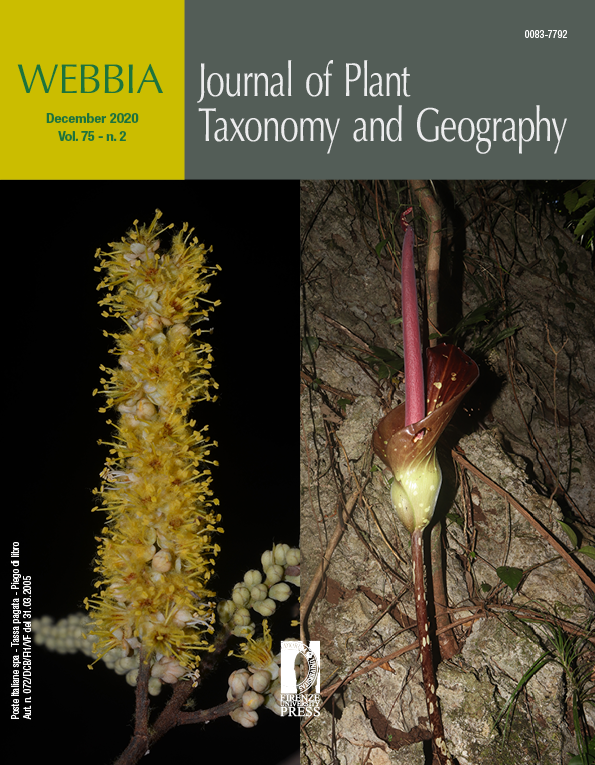Tachigali inca (Caesalpinioideae – Leguminosae), a new species of giant tree from Amazonian forests
Published 2020-11-18
Keywords
- Amazon region,
- ant domatia,
- Fabaceae,
- taxonomy
How to Cite
Abstract
The new species Tachigali inca is described and illustrated. It grows in lowland ‘terra firme’ forest of Amazonian Brazil, in the sub-Andean Amazon region of Peru, and in northeastern Bolivia. The species differs markedly from its most closely related species (T. amarumayu, T. prancei and T. setifera, all belonging to the “setifera group”), by the large cylindrical domatia on the leaf rachis, and by the brown-orange pulverulent indumentum on the abaxial surface of the leaflets and the young twigs; on older branches the indumentum becomes darker, degrades and then breaks off. It also differs by its linear petals with the upper half densely tomentose, the hairs forming small tufts.
References
Bachman S, Moat J, Hill AW, de la Torre J, Scott B. 2011. Supporting Red List threat assessments with GeoCAT: Geospatial conservation assessment tool. ZooKeys 150: 117–126.
Baker TR, Pennington RT, Magallon S, Gloor E, Laurance WF, Alexiades M, Alvarez E, Araujo A, Arets EJ, Aymard G, et al. 2014. Fast demographic traits promote high diversification rates of Amazonian trees. Ecology Letters 17: 527–36.
Baker TR, Pennington RT, Dexter KG, Fine PVA, Fortune-Hopkins H, Honorio EN, Huamantupa-Chuquimaco I, Klitgård BB, Lewis GP, de Lima HC, et al. 2017. Maximising synergy among tropical plant systematists, ecologists, and evolutionary biologists. Trends Ecol. Evol. 32:258–267.
Beentje H, Hickey M, King C. 2001. The Cambridge Illustrated Glossary of Botanical Terms. Kew Bulletin. https://doi.org/10.2307/4110976.
Dwyer JD. 1954. The Tropical American Genus Tachigalia Aubl. (Caesalpiniaceae ). Annals of the Missouri Botanical Garden 41(2): 223–260.
Dwyer JD. 1957a. The tropical American genus Sclerolobium Vogel (Caesalpiniaceae). Lloydia 20: 67–117.
Dwyer JD. 1957b. The tropical American genus Sclerolobium Vogel (Caesalpiniaceae). Lloydia 20 (Suppl.): 266–267.
Ellis B, Daly DC, Hickey LJ, Mitchell JD, Johnson KR, Wilf SL. 2009. Manual of leaf architecture. New York: Cornell University Press, Ithaca.
ESRI. 2013. ArcGIS Desktop: Release 10.2. Redlands CA.
Eva H, Huber O, Achard F, Balslev H, Beck S, Behling H, Salo J. 2005. A proposal for defining the geographical boundaries of Amazonia. A proposal for defining the geographical boundaries of Amazonia. https://doi.org/ISBN 9279000128.
Font Quer P. 1989. Diccionario de botánica. Pp. 1244. Labor, Barcelona.
Huamantupa-Chuquimaco I, de Lima HC, Cardoso DBOS, Yuca-Rivas R, Ochoa JÁ, Huamán de la Vega D. 2019. Tachigali amarumayu (Leguminosae), a new species from terra firme forests of Southwestern Amazonia. Brittonia 71 (1): 39–48.
Huamantupa-Chuquimaco I, de Lima HC, Cardoso DBOS, Huamán de la Vega D, Luza-Victorio MA. 2016. Sinopsis taxonómica, ecológica y etnobotánica del género Tachigali Aubl. (Leguminosae) en la región del Cusco, Perú. Q’EUÑA 30: 7–30.
Lewis G, Schrire BBM, Look ML. (eds) 2005. Legumes of the World. Richmond, U.K.: Royal Botanic Gardens, Kew.
LPWG. 2017. A new subfamily classification of the leguminosae based on a taxonomically comprehensive phylogeny. Taxon 66: 44–77.
Myers N, Mittermeier RA, Mittermeier CG, da Fonseca GAB, Kent J. 2000. Biodiversity hotspots for conservation priorities. Nature 403: 853–858
Payne WW. 1978. A Glossary of Plant Hair Terminology. Brittonia 30: 239–255.
Polhill RM. & Raven RH. (eds) 1981. Advances in legume systematics, part 1. Richmond, U.K: Royal Botanic Gardens, Kew.
Schmid R, Harris JG, Harris MW. 2002. Plant Identification Terminology: An Illustrated Glossary. https://doi.org/10.2307/1554893.
ter Steege H., Pitman NCA, Sabatier D., Baraloto C, Salomão RP, et al. 2013. Hyperdominance in the Amazonian tree flora. Science 342: 1243092.
ter Steege, H, Henkel TW, Helal N, Marimon BS, Marimon-Junior BH, Huth A, et al. 2019. Rarity of monodominance in hyperdiverse Amazonian forests. Scientific Reports 9:13822
Theobald WL, Krahulik JL, Rollins CR. 1979. Trichome description and classification. Pp. 0–53. In: Metcalfe L. & Chalk C. (eds.), Anatomy of the dicotyledons. Oxford.
Thiers B. 2019. Index Herbariorum: A Global Directory of Public Herbaria and Associated Staff. New York Botanical Garden’s Virtual Herbarium. http://sweetgum.nybg.org/ih/

